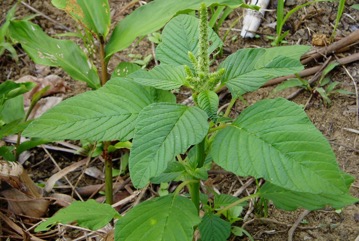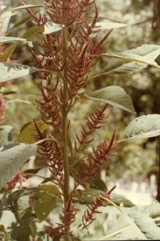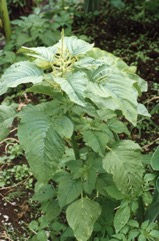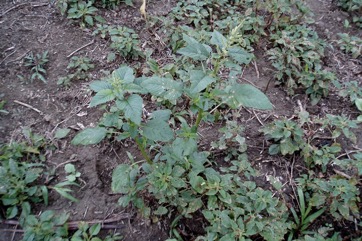Grain Amaranth

A tropical plant. It can grow in warm temperate places. It cannot tolerate frost. Plants do best under high light, warm conditions and dry conditions. They need a well drained soil. Some varieties can tolerate pH up to 8.5 and there is some salt tolerance. It can grow in arid places. In the Andes it grows between 500-3,000 m above sea level. In PNG it grows best between 1,600-2,400 m above sea level. It suits hardiness zones 8-11.
Also known as:
Alayyafoo, Anantmul, Bayam selaseh, Bayam, Biteku teku, Bonoongue, Bowa, Chalwai, Champayang, Chapata, Chailai, Damkhon, Dankhar, Den duoi-ngan, Diega krakoen, Eyasu, Gegebsa, Gimboa, Inca wheat, Kattucheera, Kedar chua, Keikera, Kempukeere soppu, Kiwicha, Kyet-mauk, Latte sag, Libondwe, Lishalisho, Love-lies-bleeding, Massaagu, Mboamanga, Moricha sak, Ocobo, Palengsag, Pendant amaranth, Prince-of-Wales Feather, Quinoa de castilla, Qunembi, Ram dana, Raso, Repati ščir, Siru kiray, Tassel Flower, Thandu keerai, Thota kura, Tianximi, Wei sui xian, Ximi, Yani
Synonyms
- Amaranthus caudatus subsp. mantegazzianus (Pass.) ined.
- Amaranthus caudatus subsp. saueri V. Jehlik
- Amaranthus caudatus var. albiflorus Moq.
- Amaranthus caudatus var. alopecurus Moq.
- Amaranthus dussii Sprenger
- Amaranthus edulis Speg.
- Amaranthus leucocarpus S. Watson
- Amaranthus mantegazzianus Pass.
Edible Portion
- Leaves, Seeds, Vegetable
Where does Grain Amaranth grow?
Found in: Africa, Andes, Angola, Argentina, Asia, Australia, Bolivia, Cameroon, Canada, Central Africa, Central African Republic, CAR, China, Congo, East Africa, East Timor, Ecuador, Eritrea, Eswatini, Ethiopia, Europe, Gabon, Guiana, Guianas, Himalayas, India, Indochina, Indonesia, Kenya, Korea, Malawi, Malaysia, Maldives, Mozambique, Myanmar, Nepal, Niger, Nigeria, North America, Northeastern India, NW India, Pacific, Pakistan, Papua New Guinea, PNG, Peru, Philippines, Sao Tome and Principe, SE Asia, Sierra Leone, Sikkim, Slovenia, South Africa, Southern Africa, South America, Spain, Suriname, Swaziland, Thailand, Tibet, Timor-Leste, Turkey, Uganda, Vietnam, West Africa, Zambia
Notes: Seed (Fresh weight) Protein: 18. There are about 60 Amaranthus species. The protein is high in lysine. It is a C4 plant. Seed is high in protein.
Status: This species is cultivated and important for its edible seed and leaves in the Andes. It is sold in markets. It is a commercially cultivated vegetable. Seed varieties have been introduced to Papua New Guinea.
Growing Grain Amaranth
Cultivation: Plants can be grown from seed if the soil is warm. Seeds are small and grow easily. Cuttings of growing plants root easily. Amaranths are mostly grown from seeds. The seeds are collected from a mature dry seed head of an old plant. These dry flower stalks are stored and then the flowers rubbed between the hands over the garden site. Collecting the seeds is fairly easy by banging flower heads on a mat or piece of cloth then the rubbish can be blown out of this mixture by dropping it and blowing gently as it falls. The very small seeds of these plants are scattered over the ashes or fine soil in fertile ground. Some types are self sown. Amaranthus seeds are very small. A thousand seeds weigh about 0.3 g. It is very difficult to sow such small seeds evenly over the ground. So there are a few different methods you can use to try and get the plants well spaced. One way is to mix the seeds with some sand and then when you sprinkle this along a row it will only contain a few seeds among the sand. The other way is to throw the seeds over a small plot of ground which will be a nursery. After 2 or 3 weeks the seedlings can be transplanted into the garden bed where they are to grow. If the seeds are just scattered over the garden, the small seedlings can be thinned out and either eaten of transplanted to a different spot. Seedlings are transplanted when about 5-7 cm tall. Plants can be harvested when small by thinning out and either transplanted or eaten cooked. Plants can be harvested whole or have top leaves harvested several times. Harvesting begins after 4-7 weeks and can continue over 2 months. A spacing of about 8 cm x 8 cm is used if the plants are to be harvested by pulling up the whole plant. If the harvesting is to be done by picking off the top leaves, a wider spacing is normally used. When the tops are picked out 3 or 4 times over the life of the one plant, a spacing about 30 cm x 30 cm is used. As far as producing a large amount of food is concerned, the spacing is not very important. Having between 200 and 1,000 plants per square metre gives about the same total amount of food. The main thing that varies is the size of the leaves. Mostly people like larger leaves so a wider spacing of 8 cm to 10 cm for plants to be pulled out is suitable. For plants to be harvested by picking out the tops, they can be picked down to about 15 cm high. Picking lower makes the plant flower later, but it also recovers more slowly from picking. Amaranths grow quickly. Seedlings come up above the ground in 3 to 5 days. They are 5 to 7 cm high and big enough for transplanting after about 20 days. The plants can be pulled out and used after 6 weeks. If they are harvested by picking out the tops, this can be started at 5 to 7 weeks and continued 3 or 4 times over the next 2 months. Amaranths eventually stop producing leaves and grow flowers. Flowering occurs after about 3 months and seed can be recollected about a month later. Amaranths are called day-length neutral plants because they still produce flowers at about the same stage, irrespective of whether there are many or few hours of daylight. Because flowering stops harvesting of leaves, it is a problem, but there does not seem to be any easy way of slowing down flowering. Flowering can be delayed a little by picking out the tops down to a lower level. Also it is made a little later if plants are grown in the shade. But lower picking and growing in the shade mean the plants produce less food, so there is no point. Plants need to be harvested and used when they are ready. If plants are left growing the amount of harvestable leaf gets less and the quality gets poorer. Nitrogen deficiency shows as the oldest leaves near the bottom of the plant going yellow. This is because the plant needs more nitrogen to grow more new leaves at the top and there is not enough nitrogen in the soil for it to get it from there. So it reuses the nitrogen it used in the oldest leaves. These leaves therefore go yellow. Potassium deficiency shows as the edges of the oldest leaves going yellow. These shortages of nutrients could be corrected by adding some nitrogen or potash fertiliser but it is most likely too late for the current crop.
Edible Uses: The leaves and young plant are eaten cooked. They are also used in stir fries and added to soups. The seeds are ground into flour and used to make bread. CAUTION: This plant can accumulate nitrates if grown with high nitrogen inorganic fertilisers and these are poisonous.
Production: Plants take 4 - 6 months from sowing to harvesting the seed, but up to 10 months in some Andean highland regions. Yields from 1-3 or 5 tonnes per hectare of seed are common. Yields of up to one kilogram of edible leaves have been harvested by pulling out plants from an area of one square metre. The young leaves or whole plants are eaten cooked. If plants are picked 3 or 4 times over 6-8 weeks then two kilograms of edible leaves can be harvested. From a plant that grows so quickly and is such good quality food this is a very high production.
Nutrition Info
per 100g edible portion| Edible Part | Energy (kcal) | Protein (g) | Iron (mg) | Vitamin A (ug) | Vitamin c (mg) | Zinc (mg) | % Water |
|---|---|---|---|---|---|---|---|
| Seeds | - | 13 | - | - | - | - | |
| Stem | - | - | - | - | - | - | |
| Leaves dry | - | 28.8 | 23.2 | 33 | - | 5.5 | 6 |
| Leaves | 59 | 5.4 | 468 | - | - | - | 80 |
Grain Amaranth Photos




References
Agong, S.G., 2006. Amaranthus caudatus L. [Internet] Record from Protabase. Brink, M. & Belay, G. (Editors). PROTA (Plant Resources of Tropical Africa / Ressources végétales de l’Afrique tropicale), Wageningen, Netherlands. < http://database.prota.org/search.htm>. Accessed 13 October 2009.
Asfaw, Z. and Tadesse, M., 2001, Prospects for Sustainable Use and Development of Wild Food Plants in Ethiopia. Economic Botany, Vol. 55, No. 1, pp. 47-62
Ambasta S.P. (Ed.), 2000, The Useful Plants of India. CSIR India. p 33
Ashagre, M., et al, 2016, Ethnobotanical study of wild edible plants in Burji District, Segan Area Zone of Southern Nations, Nationalities and Peoples Region (SNNPR), Ethiopia. Journal of Ethnobiology and Ethnomedicine (2016) 12:32
Balemie, K., & Kebebew, F., 2006, Ethnobotanical study of wild edible plants in Derashe and Kucha Districts, South Ethiopia. Journal of Ethnobiology and Ethnomedicine.
Bao Bojian; Steve Clemants, Thomas Borsch, Amaranthaceae [Draft], Flora of China
Barkatullah & Ibrar, M., 2011, Plants profile of Malakand Pass Hills, District Malakand, Pakistan. African Journal of Biotechnology Vol. 10(73) pp. 16521-16535
Berihun, T., & Molla, E., 2017, Study on the Diversity and Use of Wild Edible Plants in Bullen District Northwest Ethiopia. Hindawi Journal of Botany.Article ID 8383468
Bernholt, H. et al, 2009, Plant species richness and diversity in urban and peri-urban gardens of Niamey, Niger. Agroforestry Systems 77:159-179
Bodkin, F., 1991, Encyclopedia Botanica. Cornstalk publishing, p 74
Bourke, R. M., Altitudinal limits of 230 economic crop species in Papua New Guinea. Terra australis 32.
Brickell, C. (Ed.), 1999, The Royal Horticultural Society A-Z Encyclopedia of Garden Plants. Convent Garden Books. p 106
Burkill, I.H., 1966, A Dictionary of the Economic Products of the Malay Peninsula. Ministry of Agriculture and Cooperatives, Kuala Lumpur, Malaysia. Vol 1 (A-H) p 127
Burnie, G. (Ed.), 2003, Annuals and Bulbs. The Gardener's Handbooks. Fog City Press. p 117
Cundall, P., (ed.), 2004, Gardening Australia: flora: the gardener's bible. ABC Books. p 144
Dangol, D. R. et al, 2017, Wild Edible Plants in Nepal. Proceedings of 2nd National Workshop on CUAOGR, 2017.
Dobriyal, M. J. R. & Dobriyal, R., 2014, Non Wood Forest Produce an Option for Ethnic Food and Nutritional Security in India. Int. J. of Usuf. Mngt. 15(1):17-37
Facciola, S., 1998, Cornucopia 2: a Source Book of Edible Plants. Kampong Publications, p 8
Facciola, S., 1998, Cornucopia 2: a Source Book of Edible Plants. Kampong Publications, p 8 (As Amaranthus mantegazzianus)
FAO, 1988, Traditional Food Plants, FAO Food and Nutrition Paper 42. FAO Rome p 71
Flora of the Guianas.
Fox, F. W. & Young, M. E. N., 1982, Food from the Veld. Delta Books. p 68
French, B., 1986, Food Plants of Papua New Guinea, Asia Pacific Science Foundation p 55
Guil-Guerrero, J. L., et al, 2001, Edible Wild Plants. in Recent Progress in Medicinal Plants Vol. 8 Sci. Tech publishing, Texas
Harisha, R. P. & Padmavathy, S., 2013, Knowledge and Use of Wild Edible Plants in Two Communities in Malai Madeshwara Hills, Southern India. International Journal of Botany 9(2): 64-72.
Harter, J.(Ed.), 1988, Plants. 2400 copyright free illustrations. Dover p 16.1, 16.10
Hermandez Bermejo, J.E., and Leon, J. (Eds.), 1994, Neglected Crops. 1492 from a different perspective. FAO Plant Production and Protection Series No 26. FAO, Rome. p 12, 144
Heywood, V.H., Brummitt, R.K., Culham, A., and Seberg, O. 2007, Flowering Plant Families of the World. Royal Botanical Gardens, Kew. p 29
Hussey, B.M.J., Keighery, G.J., Cousens, R.D., Dodd, J., Lloyd, S.G., 1997, Western Weeds. A guide to the weeds of Western Australia. Plant Protection Society of Western Australia. p 80
Hu, Shiu-ying, 2005, Food Plants of China. The Chinese University Press. p 380
Ind. sem. hort. bot. Parma 4. 1865 (As Amaranthus mantegazzianus)
Jardin, C., 1970, List of Foods Used In Africa, FAO Nutrition Information Document Series No 2.p 54
Joyce, D., 1998, The Garden Plant Selector. Ryland, Peters and Small. p 312
Ju, Y., et al, 2013, Eating from the wild: diversity of wild edible plants used by Tibetans in Shangri-la region, Yunnan, China, Journal of Ethnobiology and Ethno medicine 9:28
Kang, Y., et al, 2012, Wild food plants and wild edible fungi in two valleys on the Qinling Mountains (Shaanxi, central China) Journal of Ethnobiology and Ethnomedicine; 9:26
Kanis, A in Womersley, J.S., (Ed), 1978, Handbooks of the Flora of Papua New Guinea. Melbourne University Press. Vol 1. p 22
Kays, S. J., and Dias, J. C. S., 1995, Common Names of Commercially Cultivated Vegetables of the World in 15 languages. Economic Botany, Vol. 49, No. 2, pp. 115-152
Kebebew, M. & Leta, G., 2016, Wild Edible Plant Bio-diversity and Utilization System in Nech Sar National Park, Ethiopia. International Journal of Bio-resource and Stress Management 2016, 7(4):885-896
Kiple, K.F. & Ornelas, K.C., (eds), 2000, The Cambridge World History of Food. CUP p 1717
Kishor, A., et al, 2018, Wild Food Plants of Himachal Pradesh: A Review. Plant Archives Vol. 18 No.2 pp. 2737-2751
Krishna, B., & Singh, S., 1987, Ethnobotanical Observations in Sikkim. J. Econ. Tax. Bot. Vol. 9 No. 1 pp 1-7
Lamberton, K (Ed.), 2004, The Australian gardening encyclodepia. Murdoch Books, NSW Australia. p 163
Lautenschläger, T., et al, 2018, First large-scale ethnobotanical survey in the province of Uíge, northern Angola. Journal of Ethnobiology and Ethnomedicine (2018) 14:51
Lazarides, M. & Hince, B., 1993, Handbook of Economic Plants of Australia, CSIRO. p 16
Long, C., 2005, Swaziland's Flora - siSwati names and Uses http://www.sntc.org.sz/flora/
Lucas de Arellano, M., et al, 1992, Amaranthus mantegazzianus. Chemical composition and protein biological value. (In Spanish). Arch. Latinoam Nutr. Mar: 42(1):41-5
Lulekal, E., et al, 2011, Wild edible plants in Ethiopia: a review on their potential to combat food insecurity. Afrika Focus - Vol. 24, No 2. pp 71-121
Macmillan, H.F. (Revised Barlow, H.S., et al), 1991, Tropical Planting and Gardening. Sixth edition. Malayan Nature Society. Kuala Lumpur. p 351
Malaisse, F., 1997, Se nourrir en floret claire africaine. Approche ecologique et nutritionnelle. CTA., p 57
Malaisse, F., 2010, How to live and survive in Zambezian open forest (Miombo Ecoregion). Les Presses Agronomiques de Gembloux.
Martin, F.W. & Ruberte, R.M., 1979, Edible Leaves of the Tropics. Antillian College Press, Mayaguez, Puerto Rico. p 173
Masters, T., 2021, Traditional food plants of the upper Aswa River catchment of northern Uganda—a cultural crossroads. Journal of Ethnobiology and Ethnomedicine (2021) 17:24
Molla, A., Ethiopian Plant Names. http://www.ethiopic.com/aplants.htm
Narayanan Ratheesh, M. K. et al, 2011, Wild edible plants used by the Kattunaikka, Paniya and Kuruma tribes of Wayanad District, Kerala, India. Journal of Medicinal Plants Research Vol. 5(15), pp. 3520-3529
Negi, P. S. & Subramani, S. P., 2015, Wild Edible Plant Genetic Resources for Sustainable Food Security and Livelihood of Kinnaur District, Himachal Pradesh, India, International Journal of Conservation Science. 6 (4): 657-668
Ochse, J.J. et al, 1931, Vegetables of the Dutch East Indies. Asher reprint. p 21
Ogle, B. M., et al, 2003, Food, Feed or Medicine: The Multiple Functions of Edible Wild Plants in Vietnam. Economic Botany 57(1): 103-117
Paczkowska, G. & Chapman, A.R., 2000, The Western Australian Flora. A Descriptive Catalogue. Western Australian Herbarium. p 136
Peekel, P.G., 1984, (Translation E.E.Henty), Flora of the Bismarck Archipelago for Naturalists, Division of Botany, Lae, PNG. p 164, 165
Pegu, R., et al, 2013, Ethnobotanical study of Wild Edible Plants in Poba Reserved Forest, Assam, India. Research Journal of Agriculture and Forestry Sciences 1(3):1-10
Pham-Hoang Ho, 1999, An Illustrated Flora of Vietnam. Nha Xuat Ban Tre. p 727
Plants for a Future database, The Field, Penpol, Lostwithiel, Cornwall, PL22 0NG, UK. http://www.scs.leeds.ac.uk/pfaf/
Plants for a Future database, The Field, Penpol, Lostwithiel, Cornwall, PL22 0NG, UK. (Also as Amaranthus edulis) (As Amaranthus mantegazzianus)
Plowes, N. J. & Taylor, F. W., 1997, The Processing of Indigenous Fruits and other Wildfoods of Southern Africa. in Smartt, L. & Haq. (Eds) Domestication, Production and Utilization of New Crops. ICUC p 185
Polunin, O., & Stainton, A., 2006, Flowers of the Himalaya, Oxford India Paperbacks. p 339
Pradhan, R., et al, 2020, Potential Wild Edible Plants and its Significance in Livelihood of Indigenous People of Male Mahadeshwara Hills, Karnataka. Economic Affairs Vol. 64, No. 4 pp. 01-14
PROSEA (Plant Resources of South East Asia) handbook Volume 10 Cereals. p 75
Purseglove, J.W., 1968, Tropical Crops Dicotyledons, Longmans. p 624
Radha, B., et al, 2013, Wild Edible Plant Resources of the Lohba Range of Kedarnath Forest Division (KFD), Garhwal Himalaya, India. Int. Res J. Biological Sci. Vol. 2 (11), 65-73
Rana, J.C. et al, 2011, Genetic resources of wild edible plants and their uses among tribal communities of cold arid regions of India. Genetic Resources and Crop Evolution. 59:135-149
Rao, M. L. S., et al, 2014, Indigenous Plant Foods which are commonly consumed by the tribal communities in Dumbriguda Area of Visakhapatnam District, Andhra Pradesh, India. Biolife. Vol 2, Issue 3
Raponda-Walker, A & Sillans, R., 1961, Les Plantes Utiles du Gabon. Editions Paul Lechevalier, Paris. p 48
Rashid, A., Anand, V.K. & Serwar, J., 2008, Less Known Wild Plants Used by the Gujjar Tribe of District Rajouri, Jammu and Kashmir State. International Journal of Botany 4(2):219-244
Rasingam, L., 2012, Ethnobotanical studies on the wild edible plants of Irula tribes of Pillur Valley, Coimbatore district, Tamil Nadu, India. Asian Pacific Journal of Tropical Biomedicine. (2012) S1493-S1497
Regassa, T., et al, 2014, Ethnobotany of Wild and Semi-Wild Edible Plants of Chelia District, West-Central Ethiopia. Science, Technology and Arts Research Journal. 3(4): 122-134
Royal Botanic Gardens, Kew (1999). Survey of Economic Plants for Arid and Semi-Arid Lands (SEPASAL) database. Published on the Internet; http://www.rbgkew.org.uk/ceb/sepasal/internet [Accessed 24th March 2011]
Ruiters-Welcome, A. K., 2019, Food plants of southern Africa. Ph.D. thesis. Univ. of Johannesburg p 10
Sasi, R. et al, 2011, Wild edible plant Diversity of Kotagiri Hills - a Part of Nilgiri Biosphere Reserve, Southern India. Journal of Research in Biology. Vol. 1 No. 2, pp 80-87
Saur, J.D., Grain amaranths, in Simmonds, N.W., (Ed.), 1979, Evolution of Crop Plants. Longman. p 4
Savita, et al, 2006, Studies on wild edible plants of ethnic people in east Sikkim. Asian J. of Bio Sci. (2006) Vol. 1 No. 2 : 117-125
Shah, S. K., 2014, Dietary contribution of underutilized minor crops and indigenous plants collected from uncultivated lands and forests in Nepal. in Promotion of Underutilized Indigenous Food Resources for Food Security and Nutrition in Asia and Pacific. FAO. Bangkok p 64
Sharma, B.B., 2005, Growing fruits and vegetables. Publications Division. Ministry of Information and broadcasting. India. p 189
Sillitoe, P. 1995, An Ethnobotanical Account of the Plant Resources of the Wola Region, Southern Highlands Province, Papua New Guinea. J. Ethnobiol. 15(2): 201-235
Small, E., 2009, Top 100 Food Plants. The world's most important culinary crops. NRC Research Press. p 69
Sp. pl. 2:990. 1753
Sujanapal, P., & Sankaran, K. V., 2016, Common Plants of Maldives. FAO & Kerala FRI, p 31
Swaziland's Flora Database http://www.sntc.org.sz/flora
Tapia, M. E., The role of under-utilised plant species with regard to increased food security and improved health of poor poeople, in mountain regions. IIAP-PNUD/Peru
Terra, G.J.A., 1973, Tropical Vegetables. Communication 54e Royal Tropical Institute, Amsterdam, p 21
Thitiprasert, W., et al, 2007, Country report on the State of Plant Genetic Resources for Food and Agriculture in Thailand (1997-2004). FAO p 95
Tindall, H.D., 1983, Vegetables in the tropics. Macmillan p. 36
USDA, ARS, National Genetic Resources Program. Germplasm Resources Information Network - (GRIN). [Online Database] National Germplasm Resources Laboratory, Beltsville, Maryland. Available: www.ars-grin.gov/cgi-bin/npgs/html/econ.pl (10 April 2000)
van Wyk, B., 2005, Food Plants of the World. An illustrated guide. Timber press. p 55
van Wyk, Be., & Gericke, N., 2007, People's plants. A Guide to Useful Plants of Southern Africa. Briza. p 64
Wild edible plants of Himachal Pradesh
World Checklist of Useful Plant Species 2020. Royal Botanic Gardens, Kew
www.eFloras.org Flora of China
www.pngplants.org